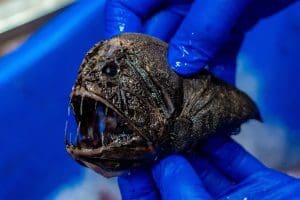
Have you ever wondered what strange and fascinating creatures inhabit the depths of the ocean? Welcome to an amazing and mysterious world, inhabited by abyssal fishes. These incredible marine species have evolved to adapt to an extreme and enigmatic environment, where darkness is absolute and the pressure is overwhelming. In this article, we will explore together the most intriguing curiosities about these rare fish that are rarely seen on the surface. From bizarre shapes and colors to astonishing hunting abilities, abyssal fishes are truly wonders of nature. Get ready to dive into the fascinating world of abyssal fishes and uncover the secrets they hold in the depths of the ocean.
Contents
¿What are Abyssal Fishes?
Abyssal fishes are a group of marine species that inhabit the depths of the ocean, in the so-called abyssal zone. This zone is located at a depth of approximately 3,000 to 6,000 meters, where darkness is absolute and pressure is overwhelming. Abyssal fishes have evolved to adapt to this extreme environment and possess unique and astonishing characteristics.
These fishes are considered some of the most mysterious inhabitants of the ocean, as they are challenging to study due to the harsh conditions in which they live. However, scientists have managed to discover some remarkable features of these fishes, which make them truly distinctive in the marine realm.
¿What are the strangest species of abyssal fish?
The abyssal depths of the ocean harbor a wide variety of fish species with unique and astonishing characteristics. These fish have developed extraordinary adaptations to survive in such an extreme environment and have evolved in remarkable ways. Here are some of the strangest and most fascinating species of abyssal fish:
1. Black Swallower (Melanocetus johnsonii):
The Black Swallower is a species of deep-sea fish that inhabits the abyssal depths of the ocean. This species belongs to the Melanocetidae family and is widely distributed in various regions of the Atlantic, Indian, and Pacific Oceans.
Physical characteristics:
 The Black Swallower has a terrifying appearance, with an almost transparent body that is black in color, and a massive mouth filled with sharp teeth. It can grow up to 25 cm in length. Its body is gelatinous and lacks scales, allowing it to move easily in the dark depths where it lives.
The Black Swallower has a terrifying appearance, with an almost transparent body that is black in color, and a massive mouth filled with sharp teeth. It can grow up to 25 cm in length. Its body is gelatinous and lacks scales, allowing it to move easily in the dark depths where it lives.
Adaptations to life in darkness:
One of the most notable characteristics of the Black Swallower is its bioluminescence. It has luminous organs in different parts of its body, such as the mouth and stomach, which allow it to attract its prey in the dark zones where it resides. Additionally, its head is mobile and can be tilted upward to attract prey with its light.
Feeding behavior:
The Black Swallower is an opportunistic predator that feeds on a wide variety of prey, including other fish, cephalopods, and crustaceans. It uses its massive mouth and sharp teeth to capture and quickly swallow its prey efficiently.
Reproduction:
Little is known about the reproduction of the Black Swallower due to its inaccessible habitat in the deep ocean. However, it is believed to have a low reproductive rate, and juveniles are thought to be pelagic, meaning they live in open waters and are carried by currents until they reach maturity.
2. The Razorfish.
 The Razorfish, also known as Sloane’s Viperfish, is a species of fish that inhabits the deep ocean. It belongs to the Stomiidae family and is widely distributed in various regions of the Atlantic, Pacific, and Indian Ocean.
The Razorfish, also known as Sloane’s Viperfish, is a species of fish that inhabits the deep ocean. It belongs to the Stomiidae family and is widely distributed in various regions of the Atlantic, Pacific, and Indian Ocean.
Physical characteristics:
The Razorfish has a long and slender body, with an average length of 15 to 20 cm. Its body is black or dark brown in color, with small, serrated scales along the edges, which gives it its common name of “Razorfish”. Its eyes are large and have a unique ability to emit their own light.
Adaptations to life in darkness:
One of the most notable features of the Razorfish is its bioluminescence. It has light-emitting organs in its body, such as photophores on the underside of its belly, which allow it to produce light to attract prey in the dark depths where it resides. In addition, its large eyes help it detect the bioluminescent light of other marine creatures in its environment.
Feeding behavior:
The Razorfish is a voracious predator that feeds primarily on small fish and crustaceans. It uses its sharp teeth to capture and tear its prey. It also has an extendable jaw that allows it to open its mouth wide and swallow prey that is much larger than itself.
Reproduction:
Information about the reproduction of the Razorfish is limited due to its inaccessible habitat in the deep ocean. It is believed to have a low reproduction rate, and the juveniles are pelagic, meaning they live in open water and are carried by currents until they reach maturity.
3. The Transparent-headed Hatchetfish.
The Transparent-headed Hatchetfish, also known as the Barreleye Fish or the Spookfish, is a species of deep-sea fish that inhabits the depths of the ocean. It belongs to the family Opisthoproctidae and is found in waters of the Pacific Ocean, from California to Japan.
Physical characteristics:
The Transparent-headed Hatchetfish has a unique and striking appearance. Its head is completely transparent, allowing it to see through it, and its eyes are large and movable, enabling it to rotate them upwards or downwards. Its body is small, with an average length of 15 to 20 cm, and has a silver or bluish coloration.
Adaptations to life in darkness:
One of the most notable features of the Transparent-headed Hatchetfish is its transparent head, which allows it to have exceptional vision in the dark depths where it lives. Its large and movable eyes are also special adaptations to detect the bioluminescence of other marine organisms in its environment.
Feeding behavior:
The Transparent-headed Hatchetfish primarily feeds on small marine organisms, such as jellyfish and zooplankton. It uses its small mouth to capture and swallow its prey, and it is believed that its transparent head enables it to observe and stalk its prey with greater precision.
Reproduction:
Little is known about the reproduction of the Transparent-headed Hatchetfish due to its difficult accessibility in the deep ocean. It is believed to have a low reproductive rate, and the eggs and larvae are pelagic, meaning they float in the water column before hatching.
Curiosities about Abyssal Fish.
These are just some of the fascinating curiosities about abyssal fish, a group of mysterious and astonishing creatures that inhabit the unexplored depths of the ocean.
1. Amazing adaptations:
Abyssal fish have developed unique adaptations to survive in the dark depths of the ocean. These adaptations include translucent or bioluminescent bodies that allow them to camouflage or produce their own light to attract prey.
2. Unusual hunting strategies:
Due to the scarcity of food in the deep ocean, abyssal fish have developed unconventional hunting strategies. Some species have enormous mouths and extendable stomachs that allow them to swallow prey much larger than themselves. Others use luminous or bioluminescent organs to attract their prey.
3. Little-known species:
Despite the vastness of the ocean, new species of abyssal fish are still being discovered regularly. Many of these species are little-known and have unique and surprising characteristics that continue to awe scientists and ocean enthusiasts.
4. Extreme depths:
Abyssal fish can be found in some of the deepest zones of the ocean, including the Mariana Trench, which is the deepest known point in the world’s oceans. Some species of abyssal fish have been found at depths exceeding 8,000 meters, making them some of the deepest dwellers on Earth.
5. Life in extreme conditions:
The depths of the ocean are known for having extreme conditions, such as lack of light, high pressures, and cold temperatures. Abyssal fish have developed unique physiological and biochemical adaptations to survive in these extreme conditions, making them true survivors.
6. Scientific importance:
Abyssal fish are of great scientific interest due to their adaptation to extreme environments and their role in marine ecosystems. Studying these species can help scientists better understand the biology, ecology, and evolution of marine organisms, as well as the dynamics of deep ocean ecosystems.
7. Threats and conservation:
Although abyssal fish are little-known and rarely interact with human activities, they face threats such as pollution, bycatch, and climate change. The conservation of these organisms and their habitat is important for maintaining the overall health of marine ecosystems and preserving the biodiversity of the deep ocean.
The Importance of Deep-Sea Fish Conservation.
- Biodiversity: Deep-sea fish species are part of the rich biodiversity of the ocean, and their conservation is essential to maintain the balance of marine ecosystems. As unique species adapted to the extreme conditions of the abyssal depths, they contribute to the biological diversity of the ocean and its resilience to environmental disturbances.
- Scientific research: Deep-sea fish are the subject of study and scientific research, as their biology, ecology, and evolution are still poorly understood. Studying these species can provide valuable information for understanding life in extreme environments, adaptation to adverse conditions, and the evolution of marine organisms.
- Ecological importance: Deep-sea fish play an important role in the food web of deep-sea ecosystems. As predators and prey, they contribute to maintaining the balance and structure of trophic networks in these areas. The conservation of deep-sea fish is crucial for maintaining the health and functioning of marine ecosystems and protecting the integrity of trophic networks.
- Economic value: Although deep-sea fish are not extensively exploited commercially, some species have potential for use in the food and pharmaceutical industries due to their unique biological and chemical characteristics. The conservation of these species ensures their availability for possible future uses and prevents the loss of economic opportunities.
- Natural heritage: Deep-sea fish represent an important part of the natural heritage of the ocean and the legacy passed on to future generations. These unique and fascinating species have intrinsic value and deserve to be conserved as part of the natural heritage of our planet.
- Awareness and education: The conservation of deep-sea fish also contributes to raising public awareness about the importance of protecting the oceans and their biodiversity. Outreach and education about these organisms and their conservation can foster understanding, appreciation, and care for the ocean and its inhabitants, promoting positive actions for their conservation.

If you’re a fish lover and want to learn about the curiosities of the famous clownfish, I invite you to click here.



